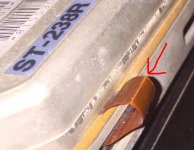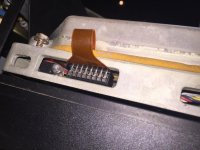Upcoming Events:
| VCF West | Aug 01 - 02 2025, | CHM, Mountain View, CA |
| VCF Midwest | Sep 13 - 14 2025, | Schaumburg, IL |
| VCF Montreal | Jan 24 - 25, 2026, | RMC Saint Jean, Montreal, Canada |
| VCF SoCal | Feb 14 - 15, 2026, | Hotel Fera, Orange CA |
| VCF Southwest | May 29 - 31, 2026, | Westin Dallas Fort Worth Airport |
| VCF Southeast | June, 2026 | Atlanta, GA |
-
Please review our updated Terms and Rules here
- Forums
- Companies
- IBM Computers, PCs, Clones and Descendants
- PCs and Clones (XT and early AT class machines)
You are using an out of date browser. It may not display this or other websites correctly.
You should upgrade or use an alternative browser.
You should upgrade or use an alternative browser.
Replace RLL Hard Disk flex?
- Thread starter gleegum
- Start date
Chuck(G)
25k Member
Have you examined the cable under magnification to see if there are any broken conductors? You may be able to patch with some of the silver-based ink that's used to repair PCB traces and rear-window defrost conductors on cars.
I'd recommend that before opening the HDA.
I'd recommend that before opening the HDA.
I'll check it, not sure if the silver glue works, I tried to repair an Amiga keyboard membrane eith that thing and it didn't work.Have you examined the cable under magnification to see if there are any broken conductors? You may be able to patch with some of the silver-based ink that's used to repair PCB traces and rear-window defrost conductors on cars.
I'd recommend that before opening the HDA.
Thank you.
abandonware
Member
Clearly the flex is cut and can not be repaired with conductive ink. In my view, you must open the hard disk and replace the flex. The problem is getting a new flex or one from a donor drive.
When you open the disc be very careful with parts and try to have the disc open the shortest possible time and do it in a clean environment and windless. Try first with the donor disk to learn how to open it and see how it is inside before opening the disk to repair.
When you open the disc be very careful with parts and try to have the disc open the shortest possible time and do it in a clean environment and windless. Try first with the donor disk to learn how to open it and see how it is inside before opening the disk to repair.
Stone
10k Member
I have a Seagate ST-225 that's kinda flakey that you could use for parts. FWIW, the hardware is the same as the ST-238R.
Chuck(G)
25k Member
Clearly the flex is cut and can not be repaired with conductive ink. In my view, you must open the hard disk and replace the flex. The problem is getting a new flex or one from a donor drive.
The flex looks cracked to me. But I'm not sanguine about one's ability to replace the whole thing--and then, it's a craps shoot if the thing can be made to work. There are several good videos on repairing/splicing flex cables Here's one.
If there's nothing important on the drive, I'd probably just bin it. The failure rate of old MFM/RLL drives is pretty high, particularly consumer-grade ones like ST238.
diskettenfett
Member
- Joined
- Feb 8, 2014
- Messages
- 19
Don't open the drive! Scrape the cracked part down to bare copper and solder short thin magnet wire pieces onto it to repair it. Then apply multiple polyurethane coats or even a thin layer of hot glue to stabilize it and there you go. Been there, done that, worked fine. Takes an hour and might save a good drive with good bearings.
NeXT
Veteran Member
I wouldn't even bother with the magnet wire. I'd just butt the break as close as it can be to the other half and flow the solder over both.
lyonadmiral
Veteran Member
If there's nothing important on the drive, I'd probably just bin it. The failure rate of old MFM/RLL drives is pretty high, particularly consumer-grade ones like ST238.
Chuck,
Just because I'm curious, in your experience, is it a particular component that is failing across these drives or is each drive failure different?
-D
Stone
10k Member
I don't have any hard evidence but I suspect that many of them are dying because of track 0 issues.
compu_85
Experienced Member
In the case of stepper motor drives, I'd wonder if you could "bring them back" by changing the head / stepper position just a teeny bit.
-J
-J
Stone
10k Member
I've heard that can work but I've never had any success with that method.
Chuck(G)
25k Member
Chuck,
Just because I'm curious, in your experience, is it a particular component that is failing across these drives or is each drive failure different?
You could well ask the same thing about people. But mostly, I think the heads start to fail, then perhaps the coating--servo tracks go bad, etc.
NeXT
Veteran Member
Chuck,
Just because I'm curious, in your experience, is it a particular component that is failing across these drives or is each drive failure different?
-D
RLL drives were always rather unreliable. They were often drives picked off the production line that had scored especially good on testing so they were more likely to handle the RLL encoding method more reliably. Of course after 20+ years that kind of reliability is not expected compared to the traditional MFM encoding.
I also suspect a lot of the older MFM drives are being disposed of because nobody wants to actually research why they are failing. Delamination? Open head coil? noisy data lines? Someone doesn't know how to wire the drive up? Nodoby knows. "Because it's old" sometimes isn't a valid answer. Hold onto your damn drives. Ffs.
Last edited:
MCbx
Experienced Member
Soldering to this ribbon?
I tried with many scrap ribbons. Always the same thing, substrate foil melts before soldering melts. What are they using for soldering them, Wood's alloy?
I had a CMI Octagon (?Kalok with re-branding stickers?) with dying ribbon (similar thing as in this Seagate, pushed by front panel bracket), it was possible to fix it a different way. I located two broken tracks, exposed them and used a wire glued to parts above/below the exposed area. Before, I inserted a piece of paper folded few times under ribbon. Next, I applied a thin piece of plastic and another layer of glue to keep exposed part from oxidation as copper passivates. After securing with sticky tape, I pushed the cable again using bracket to maintain a nice pressure and keep contact. Risky method as there is no second chance after applying glue (and no way to check that it works), but this Octagon is still working nicely (except few bad sectors at the end trimmed with partition) in one of my XTs.
I tried with many scrap ribbons. Always the same thing, substrate foil melts before soldering melts. What are they using for soldering them, Wood's alloy?
I had a CMI Octagon (?Kalok with re-branding stickers?) with dying ribbon (similar thing as in this Seagate, pushed by front panel bracket), it was possible to fix it a different way. I located two broken tracks, exposed them and used a wire glued to parts above/below the exposed area. Before, I inserted a piece of paper folded few times under ribbon. Next, I applied a thin piece of plastic and another layer of glue to keep exposed part from oxidation as copper passivates. After securing with sticky tape, I pushed the cable again using bracket to maintain a nice pressure and keep contact. Risky method as there is no second chance after applying glue (and no way to check that it works), but this Octagon is still working nicely (except few bad sectors at the end trimmed with partition) in one of my XTs.


